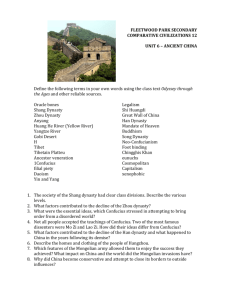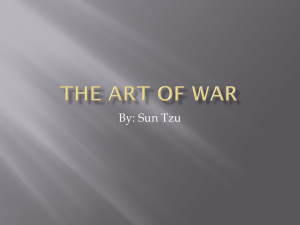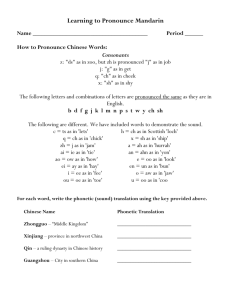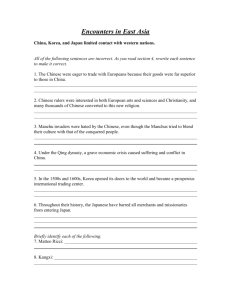1、教学内容
advertisement
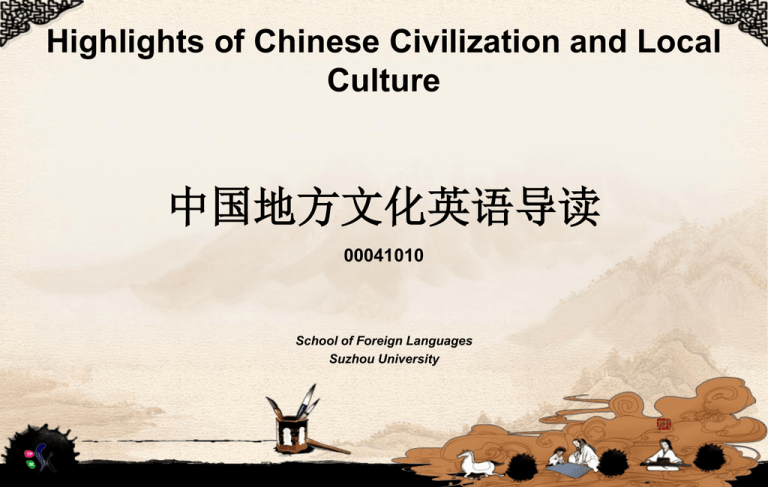
Highlights of Chinese Civilization and Local Culture 中国地方文化英语导读 00041010 School of Foreign Languages Suzhou University 第四章 文化精粹(Culture) • • • • • • • • • 1、教学内容: 了解重要文化遗址、各历史时期文学特征以及曲艺艺术。 讲授内容: (1). 中国的重要文化遗址和内容:三星堆文化、司母戊方鼎、良 渚美玉、长信宫灯、秦始皇陵兵马俑、永乐大钟、敦煌莫高窟 (2). 中国古代文学作品:中国古代史书和文学著作 (3). 现代文学发展及其代表作 (4). 中国传统表演艺术:京剧、地方戏曲、杂技、曲艺的特征 2、教学要点: 重点掌握中国重要文化遗址的文化内涵及其对中华文明研究的重 要意义。 Contents Cultural Relic Literary Work Historical Writing Literature Performing Art Cultural Relic Sanxingdui Culture Simuwu Ding Liangzhu Jade Changxin Palace Lantern Terracotta Warrior Great Bell of Yongle Dunhuang Mogao Grotto around 3,000 to 5,000 years ago jade ware, bronze human statues and ivories (the holy icons, sacrificial instruments and offerings used in the ancestral temples ) an outstanding representative of the Chinese ancient civilization on the upper reaches of the Yangtze River the biggest bronze ware unearthed in China kui (a one-legged mythical animal) is carved on four sides of the ding a cooking utensil; a sacrificial vessel (made to commemorate the king’s mother ) a high level of casting technique and artistry of the Shang Dynasty 夔(kui):传说中国东 海上有一座“流破山”, 夔就居住在此山之上。 夔的身体和头象牛,但 是没有角,而且只有一 条腿,浑身青黑色。据 说夔放出如同日月般的 光芒和雷鸣般的叫声, 只要它出入水中,必定 会引起暴风。在黄帝和 蚩尤的战争中,黄帝捕 获了夔,用它的皮制作 军鼓,用它的骨头作为 鼓槌,结果击打这面鼓 的声响能够传遍方圆500 里,使黄帝军士气大振、 蚩尤军大骇。 清乾隆 青花夔龙盘 宋 铜夔龙双耳三足鼎 清 象牙夔龙立耳四足鼎 The Liangzhu Culture良渚 文化(3400~2250 BC) was the last Neolithic jade culture in the Yangtze River Delta. Religion was of considerable importance and religious structures were elaborate. “Gold has a value; jade is invaluable” is a Chinese saying. 神人兽面纹玉琮 玉壁 钺 It represents the bronze art of the Han Dynasty. It combines aesthetics and scientific technologies, decoration and practicality. It is shaped like a maid of honor on her knees holding a lantern. The lantern holder, base, cover and even the maid’s head and arm can all be re-assembled. 长信宫灯 The terracotta warriors and horses were used as burial objects to accompany the First Emperor in the afterworld. The army consists of ife-size figures of warriors, in different battle dresses according to rank and unit, together with numerous figures of horses and chariots. The Great Bell of Yongle was regarded as a guardian and a symbol of the greatest dignity of the imperial power. Emperor Chengzu initiated three great projects, the Forbidden City, the Temple of the Heaven and the Yongle Bell. http://v.youku.com/v_show/id_co00XMTg0MDc5MTI=.html The Mogao Grottoes (also known as Thousand Buddha Cave) are one of three noted grottoes in China and also the largest, best preserved and richest treasure house of the Buddhist art in the world. They provide materials and sources for a study of the ancient Chinese. They were put on the list of the world cultural heritage in 1987. Historical Writing Historical Record (Shi Ji ) New Account of the Tales of the World (Shishuoxinyu) Annals of Zuo (Zuo Zhuan) The Records of the Three Kingdoms (San Guo Zhi) Intrigues of the Warring States (Zhan Guo Ce) Shi Ji By Sima Qian the first Chinese book on general history ever written in the biographical style notable in terms of characterization – setting the charaters in the historical backgrounds and the dramatic conflicts – use of individualized dialogues in its characterization – use of comparison and contrast – Being adept at language and rich in emotion New Account of the Tales of the World By Liu Yiqing the biographical stories popular during the Wei, Jin and the Southern and the Northern Dynasties initiating the biographical style novel writing (世说体 ) containing three volumes divided into 36 categories according to different subject matters such as virtue, diction, government affair, literature and generosity (德行、言语、政事、文 学、雅量 ) Annals of Zuo By Zuo Qiuming a commentary to the Spring-Autumn Annals-- the first Chinese chronological history Providing extensive narrative accounts, ample background materials and authentic historical documents and written evidence of the philosophical schools of the time San Guo Zhi By Chen Shou integrating the smaller histories of the rival states of the Three Kingdoms into a single text providing the basis for the more popular historical novel the Romance of the Three Kingdoms part of the early four historiographies of the Twenty-Four Histories (Shi Ji, the History of the Han Dynasty, the History of Latter Han) Intrigues of the Warring States outlining the strategies and political views of the School of Negotiation revealing the historical and social characteristics of the Warring States Period recounting the history from the conquest of the Fan clan by the Zhi clan in 490 BC up to the failed assassination of the First Emperor by Gao Jianli in 221 BC Literature Classical literature the earliest period --- the late Qing Dynasty (1644 – 1911) Modern literature the late Qing Dynasty --- 1949 Contemporary literature since 1949 Classical Literature Classic of Ode (诗经) I. the first poem collection II. Feng, Ya, Song III. Fu (narrative) Bi (figuration simile and metaphor) Xing (symbolization and contrast) Four Books and Five Classics (四书五经) I. Four Books II. the Great Learning, the Doctrine of the Mean, the Confucian Analects and the Works of Mencius compiled and annotated by Zhu Xi Five Classics the Book of Songs, Collections of Ancient Texts, the Rites, the Book of Changes and the Spring and Autumn Annals entitled during the reign of Emperor Wudi of the Han Dynasty I. Collection of Yuefu Poetry compiled during the Song Dynasty by Guo Mao Qian II. Yuefu was originally the official bureau in charge of compiling music books, anthologizing songs and ballads and training musicians. III. containing the poetry from the Han Dynasty to the Five Dynasties and the ballads from the Preqin period to the last phase of the Tang Dynasty I. Ci / Song Lyrics akin to lyrics created for musical accompaniment as the meter varied in the way that the words had to match the rhythm of the music II. According to its length, Ci can be divided into Xiao Ling (less than 58 characters), Zhong Diao (59~90 characters), and Chang Diao (more than 91 characters). III. Cipai is the name of the tonal pattern that designates the rhythm and form of a verse,such as the Beautiful Lady Yu, Buddha Dance, and Wine Spring (酒泉子). IV. Ci has two main genres, Wanyue (graceful and mild) and Haofang (bold and unconstrained). I. II. Qu (Drama) Qu had two forms, Sanqu and Yuanzaju. Guan Hanqing, Wang Shifu, Bai Pu, Ma Zhiyuan and Tang Xianzu III. the Injustice Done to Dou E, the West Chamber, Peony Pavilion (also entitled Annuals of Revival 还魂记 ) Novel I. the Outlaws of the Marsh --- By Shi Naian and Luo Guanzhong II. the Romance of the Three Kingdoms --- By Luo Guanzhong III. Journey to the West --- By Wu Cheng’en IV. A Dream of the Red Mansion (the Story of the Stone, the Twelve Beauties of Jinling) --- By Cao Xueqin and the last 40 chapters by Gao E V. Strange Tales of the Make-do Studio --- By Pu Songling the Outlaws of the Marsh • It reveals the stories about the Liangshan uprisings led by Song Jiang during which the rebellious heroes executed justice on behalf of the Heavens by killing the rich and helping the poor. • The heroic legendary genre of fiction created by the authors has had a great influence on the development of this genre of fiction writing. the Romance of the Three Kingdoms • It is the first traditional Chinese novel with separate and self-contained chapters. • It combines romanticism with realism. • Guan Yu, “the incarnation of personal loyalty,” Zhu Geliang, “the embodiment of wisdom”. Journey to the West • It depicts the pilgrimage journey of the Tang Monk and his disciples, and tells how they went through the 81 adversities on their journey. • The most striking features of the book are its eerie imagination and blatant exaggeration by which the writer created a grotesque, gaudy, fanciful and magical world which broke the boundary between time and space, life and death, and humans and deities. A Dream of the Red Mansion • It describes the rise and prosperity as well as the decline and downfall, of the feudal lord familial system represented by the Jia Family. • It points out that all forms of high positions and great wealth are nothing but an illusory dream which is bound to end up in a “vast expanse of empty and desolate wilderness”. Strange Tales of the Make-do Studio • The author expressed his dissatisfaction with reality via the odd and imaginary world of ghosts and fairy foxes. • The author creates a large number of nonrealistic artistic images such as the charming female ghosts and fairy foxes. Modern Literature • Lu Xun, the harbinger and master of modern literature, composed the Madman's Diary, The True Story of Ah Q. • Lao She was skillful in utilizing the Peking dialect. Camel Xiangzi and the drama Tea House are his masterpieces which reflect the helplessness of the lower classes in the old China. • Lin Yutang wrote many essays. • Xu Zhimo, a much traveled lyric poet. Other Masterpieces • Thunderstorm, (1934) -- Written by Cao Yu • Family, (1942) -- The four-act play, based on the novel so the same name by great modern Chinese writer Ba Jin • Peking Man, (1941) -- Written by Cao Yu Contemporary Literature • Poems, essays, fiction and drama in a broad spectrum of themes and in many forms are quite popular. • We now have a favorable turn on events and a great number of responsible writers deepen the literary forms and content. Nowadays literature prospers. • Literary prizes such as the Lu Xun Prize, Mao Dun Prize, … masterpieces • Cai Wenji (1959) -- Written by Guo Moruo • Longxu Slum (1951) by Lao She in 1953, modern drama • Teahouse (Chaguan, 1957) -- Written by Lao She The Performing Arts • • • • • • 1. 2. 3. 4. 5. 6. Lion Dance Nuo Dance (傩舞) Shadow Shows Acrobatics Puppet Quyi (story-telling, story-singing, and joketelling. ) • 7. Modern Chinese Drama • …… Chinese Martial Arts • • • • • • 1. Shaolinquan Kong fu 2. Tai Ji 3. Tug-of-War 4. Chinese Chess 5. Stilt-walking (踩高跷 ) …… Beijing Opera • Beijing opera has more than a 200-year history. The main melodies originated from Xipi and Erhuang, in Anhui and Hubei respectively, but over time, the techniques from many other local operas have been incorporated. • The band of Beijing opera mainly consists of orchestra and percussion. • There are four main roles in Beijing opera: sheng, dan, jing and chou. Group presentation Direction: Please elaborate on one of the specific topic listed in Chapter 4 Assignment • 观看《揭秘中华古文化》和《中国文化精粹》相关 剧集,感性了解古代文物所传承的中华文明和内涵, 讨论和思考中国古代文学和表演艺术中所蕴涵的中 华文明的基本精神元素。



